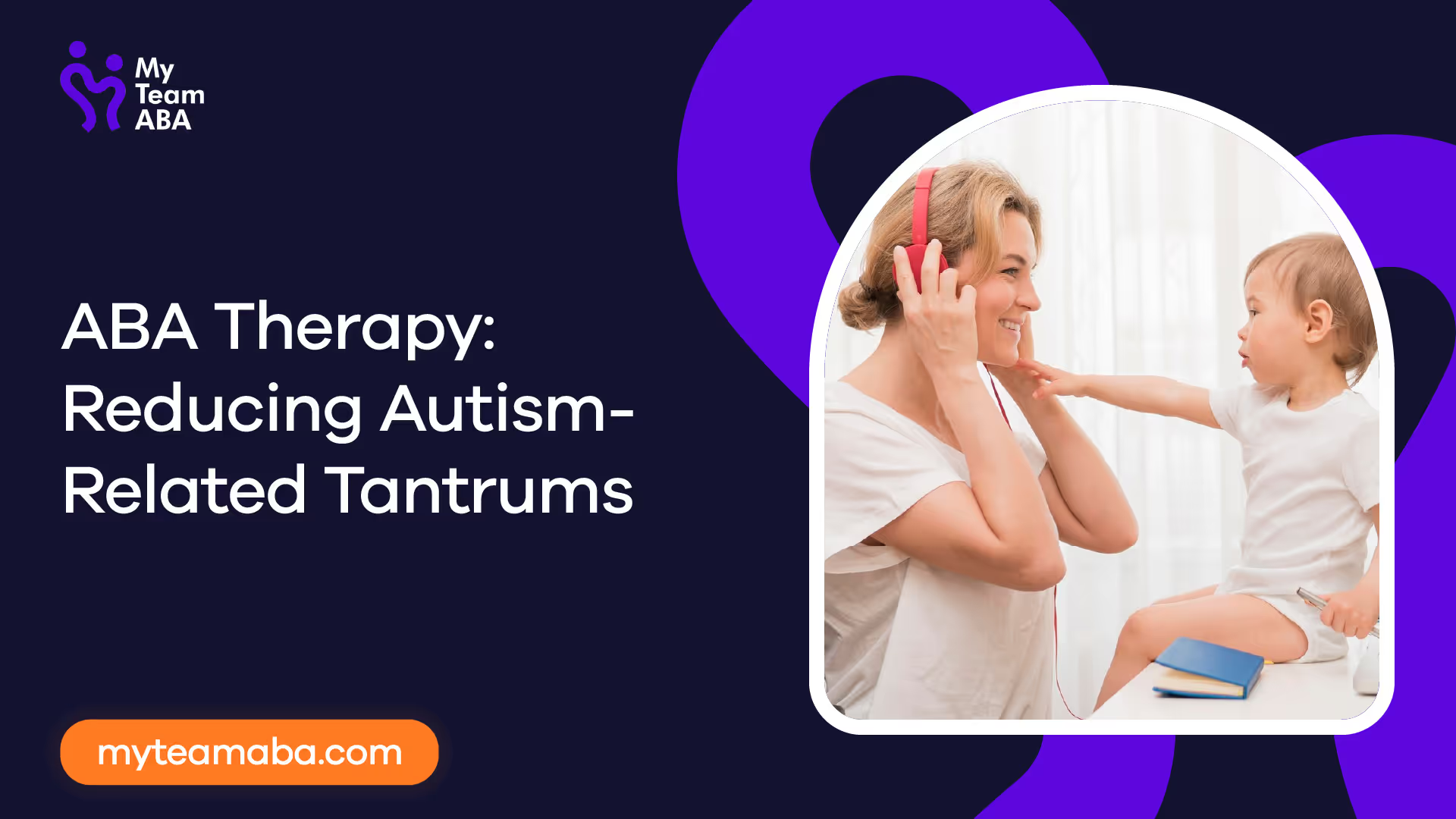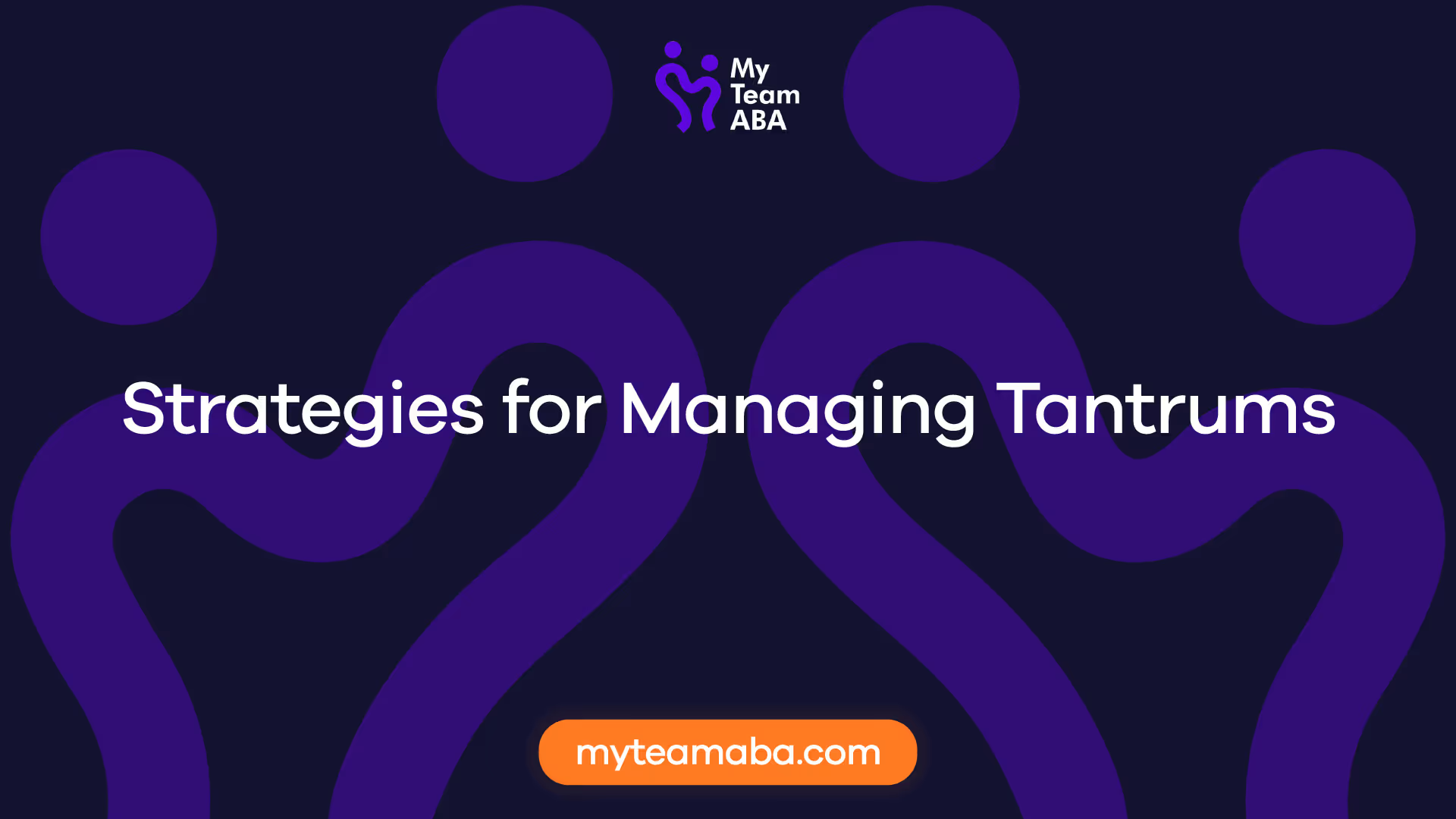ABA Therapy: Reducing Autism-Related Tantrums
March 3, 2025
Discover how ABA therapy tackles autism-related tantrums with effective strategies and individualized approaches. Find hope and support.


Understanding Autism-Related Tantrums
When it comes to children with Autism Spectrum Disorder (ASD), tantrums can be a common occurrence. Understanding the nature of tantrums in children with ASD and the functions they serve is crucial in developing effective strategies for managing these behaviors.
Exploring Tantrums in Children with ASD
Children with ASD may experience frequent temper tantrums or meltdowns for various reasons. These can include sensory overload, reinforcement of specific behaviors, and a lack of skill development in particular areas. While there is no substantial evidence indicating that individuals with autism have more tantrums than neurotypical individuals, their tantrums may be longer-lasting or more frequent [2].
It's important to note that tantrums are a form of communication for children with ASD. They may engage in tantrums as a way of expressing confusion, fear, anxiety, or stress due to limited communication skills. Tantrums may also occur when a preferred object or activity is removed or as a response to pain, discomfort, or other medical issues [3].
Functions of Behavior in Tantrums
Understanding the underlying functions of behavior in tantrums is crucial for effective intervention. Tantrums can serve various functions, including:
- Escape: Some children with ASD may engage in tantrums to escape or avoid specific situations or demands that they find challenging or overwhelming.
- Attention: Tantrums can be a way for children to gain attention from caregivers or peers, especially if they have learned that engaging in such behaviors elicits a response.
- Access to Preferred Objects or Activities: Tantrums may occur when a child is denied access to a preferred object or activity, such as a toy or a particular routine they enjoy.
- Expression of Needs: Children with limited communication skills may resort to tantrums as a means of expressing their needs or desires when other forms of communication are challenging for them.
By understanding the functions of behavior in tantrums, caregivers and professionals can tailor intervention strategies to address the specific underlying needs and motivations of the child. This can help reduce the occurrence and intensity of tantrums and promote more effective communication and emotional regulation. For more information on effective strategies for reducing autism-related tantrums, refer to our article on calming autism outbursts with ABA therapy.
To effectively manage tantrums in children with ASD, it is essential to implement strategies that target the antecedents and functions of behavior. This includes techniques such as antecedent interventions, positive reinforcement, and the use of prompts and visual supports. By addressing these factors, caregivers and professionals can provide the necessary support to help children with ASD navigate their emotions and behaviors more effectively.

Strategies for Managing Tantrums
When it comes to managing tantrums in individuals with autism spectrum disorder (ASD), implementing effective strategies is key to reducing the frequency and intensity of these behaviors. In this section, we will explore three strategies commonly used in Applied Behavior Analysis (ABA) therapy: antecedent interventions, positive reinforcement techniques, and the use of prompts and visual supports.
Antecedent Interventions
One of the fundamental strategies for managing tantrums in children with autism is to understand the underlying reason behind their behavior. This involves considering the four functions of behavior: attention, escape, access to tangibles, and automatic reinforcement. By identifying the antecedents, or triggers, that lead to tantrums, caregivers and professionals can proactively implement interventions to prevent meltdowns.
Antecedent interventions may include creating a structured daily schedule that incorporates the child's preferences and routines, setting clear expectations, and providing visual cues to help the child understand what is expected of them. For example, establishing a predictable routine that includes designated times for preferred activities can help prevent tantrums related to not getting immediate access to desired items or activities.
Positive Reinforcement Techniques
Implementing positive reinforcement is another effective strategy for managing tantrums in children with autism. This approach involves focusing on the child's positive behaviors and providing rewards or praise for engaging in appropriate alternative behaviors. By reinforcing desirable behaviors, caregivers can encourage the child to engage in more adaptive responses instead of engaging in challenging behaviors.
The specific reinforcement strategies used may vary depending on the individual's preferences and needs. It could involve providing verbal praise, offering small rewards, or using token systems where the child earns tokens for appropriate behavior that can later be exchanged for preferred items or activities. The goal is to reinforce positive behaviors that serve as alternatives to tantrums and promote overall social and emotional well-being.
Using Prompts and Visual Supports
Prompts and visual supports can be valuable tools in helping individuals with autism manage their emotions and behavior during tantrum episodes. These strategies provide additional support and guidance to assist the individual in calming down or engaging in replacement behaviors when faced with challenging situations.
Prompts can take various forms, such as verbal reminders, gestures, or physical guidance, to redirect the individual's attention and guide them towards appropriate responses. Visual supports, including visual schedules, social stories, and rule boards, offer visual cues that help individuals understand expectations, sequence of events, and appropriate behaviors in different situations.
By using prompts and visual supports, caregivers and professionals can empower individuals with autism to better regulate their emotions and navigate challenging circumstances, reducing the likelihood of tantrum behaviors.
Implementing these strategies requires consistency, patience, and individualized approaches based on the needs of the person with autism. ABA therapists and caregivers can work together to develop appropriate intervention plans tailored to each individual's specific strengths and challenges. For more information on ABA therapy for managing autism tantrums, visit our article on aba therapy for managing autism tantrums.

ABA Techniques for Tantrums
When it comes to reducing autism-related tantrums, Applied Behavior Analysis (ABA) techniques have proven to be effective. ABA focuses on understanding the functions of behavior and teaching replacement behaviors to address the underlying causes of tantrums. In this section, we will explore three key ABA techniques: functional assessment, skill-based treatment, and addressing communication and behaviors.
Functional Assessment
A functional assessment is a crucial step in understanding the reasons behind tantrum behavior in children with autism. By considering the four functions of behavior — attention, escape, access to tangibles, and automatic reinforcement — caregivers and therapists can gain insights into the triggers and maintaining factors of tantrums. Identifying the function of the behavior helps guide the development of appropriate intervention strategies.
During a functional assessment, professionals observe and collect data on the circumstances surrounding tantrums. This data helps to determine the specific conditions, events, or situations that lead to tantrums. By pinpointing the antecedents and consequences of the behavior, therapists can develop targeted interventions to reduce tantrums and promote more appropriate behaviors.
Skill-Based Treatment
Skill-based treatment (SBT) is a fundamental aspect of ABA therapy for managing tantrums in individuals with autism. SBT focuses on teaching replacement behaviors that serve the same function as the tantrum behavior but are more appropriate and socially acceptable. The goal is to equip individuals with the skills they need to effectively communicate their needs and cope with challenging situations.
Through SBT, therapists work closely with individuals to identify alternative behaviors that can fulfill their needs without resorting to tantrums. For example, teaching individuals to use appropriate communication methods, such as using words or gestures, can reduce frustration and help them express their desires or discomfort more effectively. By focusing on building these specific skills, individuals can learn positive ways to cope with their emotions and communicate their needs.
Addressing Communication and Behaviors
Communication plays a vital role in reducing tantrums in individuals with autism. ABA therapy emphasizes addressing communication deficits by teaching individuals alternative communication strategies. This can include using visual supports, augmentative and alternative communication (AAC) devices, or sign language to enhance expressive and receptive communication skills.
ABA also focuses on addressing other challenging behaviors that may contribute to tantrums. By teaching individuals appropriate behaviors to replace challenging ones, therapists can help individuals manage their emotions and respond to situations in a more adaptive manner. This may involve teaching self-regulation techniques, social skills, and coping strategies to reduce frustration and increase emotional resilience.
By utilizing functional assessment, skill-based treatment, and addressing communication and behaviors, ABA therapy offers comprehensive strategies to reduce tantrums in individuals with autism. These techniques provide individuals with the tools and skills necessary to navigate challenging situations, communicate effectively, and ultimately lead to improved overall quality of life.
Prevention and Intervention
When it comes to managing tantrums in children with autism, prevention and intervention strategies play a crucial role in promoting positive behavior and reducing outbursts. By identifying triggers, responding with praise and calmness, and implementing ABA techniques at home and school, caregivers can effectively address and manage tantrums.
Identifying Triggers
One key aspect of preventing tantrums is identifying the triggers that lead to these challenging behaviors. Common triggers for tantrums in children with autism include transitions, demands, and sensory issues. By closely observing and tracking their child's behavior, caregivers can identify patterns and antecedents that may trigger tantrums. This knowledge allows them to better understand and respond to their child's needs, helping to mitigate potential tantrum-inducing situations. For more information on managing tantrums in autism using ABA techniques, visit our article on managing tantrums in autism using ABA.
Praise and Calm Responses
One effective strategy for preventing tantrums is to provide positive reinforcement for desired behaviors. By praising positive behaviors and teaching children how to positively react to circumstances, caregivers can help prevent tantrums from occurring. Reacting calmly and empathetically during a tantrum can also help soothe the child and avoid escalating the situation. By modeling calm and composed responses, caregivers can create a supportive environment that encourages more adaptive behaviors. For additional information on calming autism outbursts with ABA therapy, see our article on calming autism outbursts with ABA therapy.
Implementing ABA at Home and School
To effectively manage and reduce tantrums, implementing Applied Behavior Analysis (ABA) techniques at home and school can be highly beneficial. ABA therapy focuses on individualized strategies that address the specific needs of each child. By conducting behavior assessments and functional analyses, professionals can identify the underlying causes of tantrums and develop targeted interventions to address these behaviors. By teaching replacement behaviors and addressing the functions of the behavior, ABA therapy helps children learn more adaptive ways to communicate and cope with their emotions. For more details on ABA therapy for managing autism tantrums, refer to our article on ABA therapy for managing autism tantrums.
By proactively identifying triggers, responding with praise and calmness, and implementing ABA techniques at home and school, caregivers can effectively reduce tantrums and create a supportive environment for children with autism. These strategies provide valuable tools for both prevention and intervention, helping children develop adaptive behaviors and enhancing their overall well-being.
ABA Therapy for Autism
When it comes to reducing autism-related tantrums, ABA therapy (Applied Behavior Analysis) has shown great promise in helping individuals with Autism Spectrum Disorder (ASD) develop appropriate behaviors and improve their overall quality of life. ABA therapy is highly individualized, with strategies chosen based on the environment and the child's specific needs. Let's explore two key components of ABA therapy for autism: individualized strategies and behavior assessment and functional analysis.
Individualized Strategies
ABA therapy is tailored to meet the unique needs of each individual with autism. The therapy begins with assessing the child's behavior, creating an operational definition of the target behavior, and conducting a functional behavior assessment (FBA) to understand the reasons behind the behavior [4]. Once the behavioral patterns are understood, individualized strategies are developed to address the specific challenges faced by each individual.
These strategies may include teaching replacement behaviors, reinforcing positive behaviors, and implementing specific interventions to mitigate challenging behaviors. The focus is on promoting positive behavior changes, enhancing communication skills, and improving social interactions. ABA therapists work closely with individuals with autism and their families to ensure that the strategies are effective and aligned with their goals.
Behavior Assessment and Functional Analysis
In ABA therapy for autism, behavior assessment and functional analysis play a crucial role in understanding the underlying causes of challenging behaviors. A behavior assessment involves gathering information about the individual's behavior through direct observation, interviews, and questionnaires. This helps identify patterns, triggers, and antecedents that contribute to tantrums and other challenging behaviors.
Functional analysis is a systematic process that delves deeper into the function of the behavior. It seeks to determine the purpose or motivation behind the behavior. By understanding the function, ABA therapists can develop interventions that address the root causes of the behavior.
Based on the results of the behavior assessment and functional analysis, ABA therapists create behavior intervention plans that are specific to each individual. These plans may include strategies such as positive reinforcement, prompting and fading techniques, visual supports, and social stories. The goal is to provide individuals with the tools and skills they need to manage their behaviors effectively and reduce tantrums.
ABA therapy for autism is a comprehensive and evidence-based approach to reducing autism-related tantrums. It focuses on understanding the individual's unique challenges, developing individualized strategies, and conducting ongoing assessments to ensure progress. By implementing ABA therapy, individuals with autism can learn to navigate their environment more effectively, improve their communication and social skills, and experience a better quality of life.
ABA Therapy Effectiveness
ABA therapy has demonstrated effectiveness in reducing autism-related tantrums and improving the overall quality of life for individuals with autism. Let's explore two key aspects of ABA therapy effectiveness: case studies on ABA success and finding effective ABA practitioners.
Case Studies on ABA Success
Case studies provide valuable insights into the effectiveness of ABA therapy in reducing autism-related tantrums. For example, a case study highlighted how ABA therapy helped a 10-year-old child with aggressive behaviors related to using his iPad. By implementing strategies such as prompting the child to ask verbally for iPad access without aggression, using visual schedules, and setting limits, the child learned healthier behaviors and reduced tantrums.
These case studies demonstrate the individualized nature of ABA therapy, with strategies tailored to the specific needs of each child. By working closely with ABA practitioners, parents can observe positive changes in their child's behavior and witness the effectiveness of ABA therapy in managing tantrums.
Finding Effective ABA Practitioners
To ensure the effectiveness of ABA therapy, it is crucial to find an ABA practitioner who is well-suited to the individual's needs. Parents should actively participate in the therapy process and collaborate closely with the ABA practitioner.
When seeking an ABA practitioner, parents are encouraged to research different agencies that work with their insurance and find a provider that fits their family's schedule. It is important to ask questions about the therapist's experience in dealing with specific behaviors and their adaptability in implementing strategies.
It is also advisable for parents to collect data on their child's behaviors and share this information with the ABA practitioner. This data helps in creating an individualized treatment plan and tracking progress over time.
Parents should be aware that there may be long waitlists for ABA therapy services. To maximize the benefits for their child, it is recommended to reach out to multiple organizations and explore different options.
Additionally, parents should inquire if their insurance covers ABA therapy and work with agencies that are in-network. Understanding insurance coverage and potential costs upfront can help in making informed decisions about ABA therapy for managing autism-related tantrums [4].
By considering case studies that highlight ABA success and carefully selecting an effective ABA practitioner, parents can ensure the effectiveness of ABA therapy in reducing autism-related tantrums and promoting positive behavior changes in their child.
